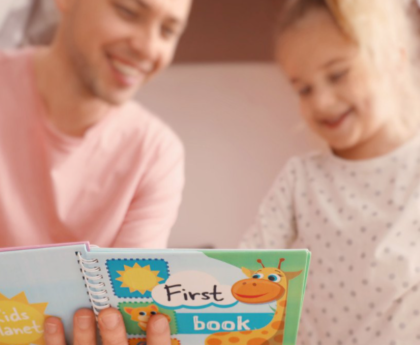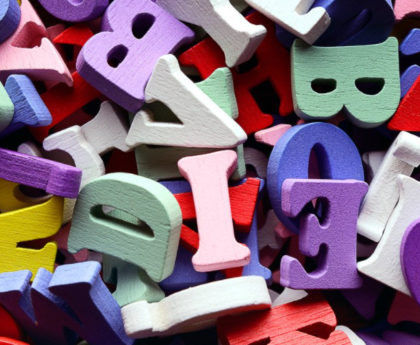Fluency is a skill that allows people to use language easily, accurately, and with expression. Reading fluency is the ability to read quickly, accurately, and with expression.
Reading fluency leads to comprehension. Reading comprehension is key to reading proficiency.
How does a child become fluent in reading, and what are some ways you can help? Let’s explore the process of becoming literate.
What is Reading Fluency?
Reading fluency is one of the five pillars of reading. It’s essential for literacy development.
Fluency in reading happens when a reader no longer needs to focus on decoding— the act of sounding out each set of letters to form whole words. It’s when reading can be done with ease, speed, and accurate expression.
When children learn to read, decoding is a required skill that’s practiced until mastery. Reading fluency is achieved when a child can read silently and out loud with clarity. Fluency is extremely important, as it helps children comprehend the meaning of text and equips them to improve their vocabulary.
Developmental Timelines and Reading Fluency Goals
Every child learns to read at their own pace. However, there are developmental benchmarks that let educators observe whether or not their students are on track. Specific reading frameworks vary by location and age group, but there are evidence-based milestones typically common in children.
These Developmental Stages of Reading are adapted from the influential phonics researcher Jeanne Chall.
1. Pre-Reading
Also known as emergent reading, pre-reading usually happens from birth to age five. Kids begin to learn phonemic awareness, meaning they understand different sounds of language and can organize sound segments. By kindergarten, students learn basic word meanings, the alphabet, alliteration, as well as rhyming.
Children in this phase often pretend to read books. They engage in storytime with parents and teachers. They know that things in print contain meaning and begin to ask about their meaning. By age four or five, children begin identifying certain words in print, such as their name, common words, and favorite characters or brands. Eventually, children learn to correlate sounds to alphabetical letters.
2. Early Reading
Early reading instruction should include phonics. During this stage, children match letters with their corresponding sounds and blend the sounds to decode (sounding out) words in print. As children learn to decode more words, they can read and understand more texts. Comprehension skills bud as students can retell parts of a story, read picture books, and pick up new vocabulary words.
3. Transitional Reading
Around second and third grade (ages 7-9), children may begin to acquire fluency. Many children learn to identify sight words, recognize spelling patterns, decode multisyllabic words, and comprehend sentences and short paragraphs. They become curious about storylines and respond emotionally to text. Some children are able to read chapter books, while others continue learning decoding. At this stage, it’s important to remember your child is learning to read at their own pace.
4. Fluent Reading
Ideally, students improve fluent reading in third and fourth grade. It takes less effort to recognize words and it becomes easier to comprehend sentences. Children can read more quickly both silently and out loud, with the ability to decode more challenging words they don’t know. They begin thinking critically about texts they read, develop more reading stamina, and practice reading a variety of subjects.
5. Reading for New Learning
From fourth grade and beyond, students read to learn new information. They develop advanced reading fluency skills. Readers spend little time on decoding, and can instead focus on comprehension and inquiry.
Advanced fluent readers like teens and adults use text to develop multiple viewpoints, expand their knowledge of hobbies or interests, and study for exams. They also read for enjoyment and discern when to skim or skip irrelevant texts.
Early Reading Frustration: Is It a Fluency Issue?
Reading is a skill that must be explicitly taught. Until children develop fluency, reading can feel like a lot of work. They have to decode one word after the other, hold words in mind to make a sentence, and then remember what they’ve worked so hard to read.
It’s common for early readers to make mistakes and become frustrated sometimes. But if a child continues to struggle or dread reading past important developmental stages, there could be a fluency issue.
Why do some children lack reading fluency for their age group? There are a few possible reasons:
- They were never taught effective literacy skills, such as phonics and phonemic awareness.
- They have different processing abilities, such as deficits in processing speed, long-term recall, or working memory.
- They have vision or hearing concerns impeding their learning progress.
- They need to practice a specific literacy skill before advancing to the next.
Without fluency, children focus a lot of cognitive resources on decoding. This leaves them with fewer resources in their energy tank to comprehend what they’re reading. They may have to read sentences multiple times or stumble over words they’re expected to know.
There’s hope, though! Since reading is learned, all of the five skills can be improved— including fluency.
Reading Fluency Strategies to Help Your Child Improve Comprehension
There are some effective activities you can do with your child to support their reading fluency development.
Reading Fluency Assessments
Reading assessments compare a child’s reading proficiency with grade-level standards. Talk with your child’s teacher or doctor about a reading assessment. This can lead to answers and also provide you with tips for how to practice reading at home.
Read With Your Child
Literacy studies show that parent involvement in a child’s reading has a significant impact on development. When parents consistently read to their children, it models fluency, which helps kids learn reading speed, expression, and accuracy.
Reading with your child also creates an emotional bond, helping them form positive attitudes about reading. Follow along with your child as they read. Gently note their reading pattern mistakes and encourage self-correction. Help them re-read misread words, practice punctuation expressions, and reflect on the story afterward.
Fluency Practice Tips
Here are more reading practices to try:
- Engage them in a fun, daily reading activity
- Reinforce letter-sounds and ‘sounding out’ words until foundational skills are mastered
- Read “decodable” books with your child. These books match the phonics knowledge and skills that have been explicitly taught and practiced.
- Perform “Reader’s Theatre” plays
- Schedule a family reading time, encouraging older siblings to read with younger siblings
- Let your child choose books they want to read
- Maintain a motivational attitude toward your child’s reading progress
- Practice choral reading as a group
- Play reading apps and fluency games with your child
Adjust your child’s reading practices according to their reading strengths, weak points, and age.
Effective Reading Fluency Games: Reading.com
To practice reading fluency at home, reading games can help.
Apps that use science-based instruction methods can help establish strong reading practices for your child, helping them master fundamental skills that enable fluent reading. Using an app like Reading.com with your child is also a great way to learn where they’re improving and what skills they need to work on.
Ready to strengthen your child’s reading and literacy development? Start a free trial of the Reading.com app to get started!





